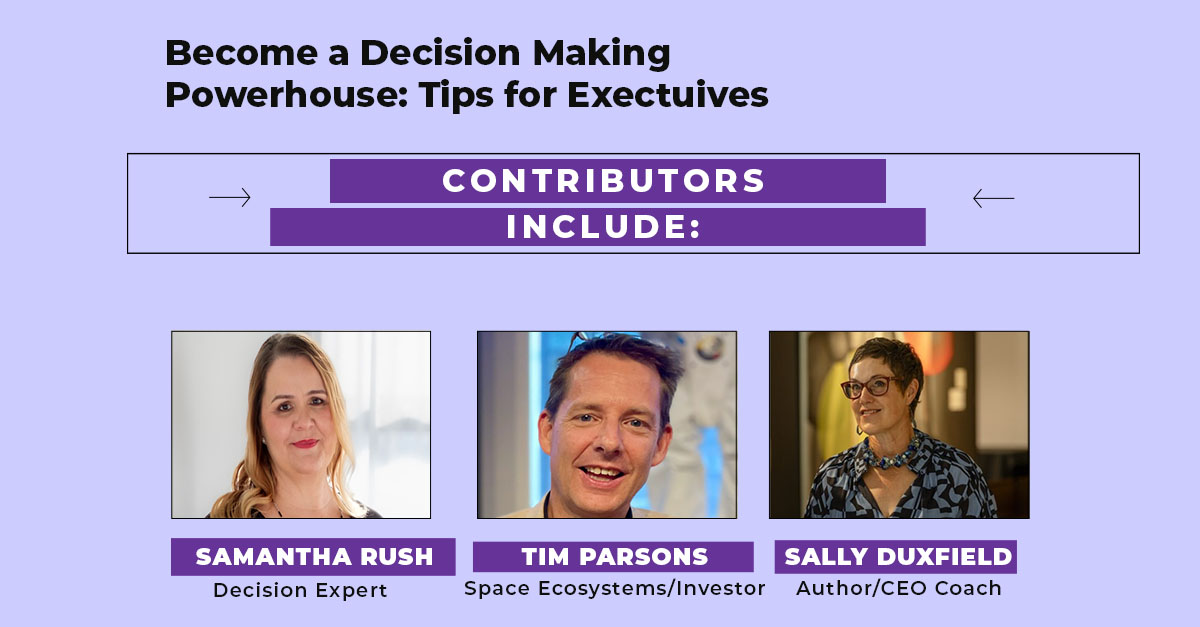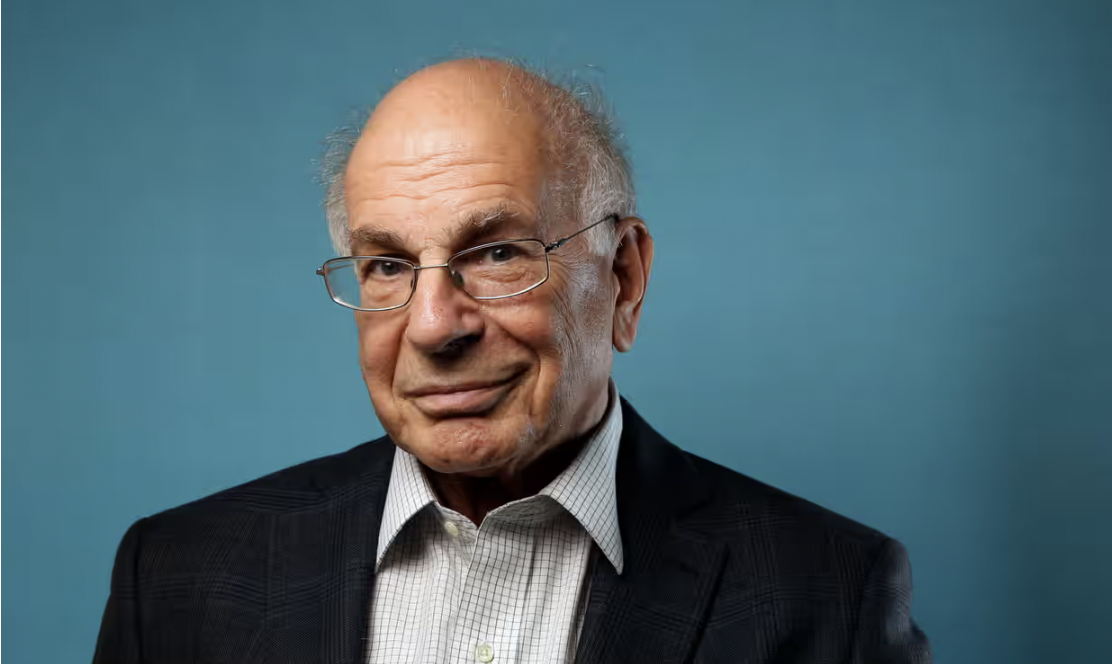Executive Tips on How to Become a Decision Making Powerhouse
Here are a few key insights: Manage Your Stress: Understand the neurobiological impacts of stress on decision-making, as explained by performance coach Sally Duxfield. She highlights the importance of managing cortisol levels to maintain clear thinking and effective decision-making under pressure. Check Your Biases: Decision-making expert Samantha Rush emphasizes the need to be aware of cognitive biases that can cloud judgment. Learn techniques to identify and counter these biases to ensure more objective decision-making. Define Success Metrics: Tim Parsons, a PhD and space ecosystem expert, advises on the importance of defining clear success metrics. This approach helps ensure that every decision aligns with your strategic goals and delivers tangible results. Trust Your Intuition and Gather Data: Transformation agent Shivani Gupta suggests balancing data-driven decisions with intuitive judgment. She offers tips on gathering data, considering alternatives, and learning from feedback to continuously improve decision-making processes.

AUTHOR: Samantha Rush, Sally Duxfield, Graham Harvey, Shivani Gupta, Tim Parsons
Dive into our latest "Decision Insights" article, where we've gathered perspectives from a diverse range of experts to offer you practical advice on navigating the challenges of high-stakes decision-making. Our thought leaders share their top strategies to help executives manage the demanding task of making hundreds of decisions each day. 1. Pay Close Attention to You Cortisol Load - It Leads to A Loss Of Executive Function In Decision Making

Sally Duxfield Performance Coach and Author The least explored or considered component of executive decision making is the understanding of the neurobiological response to stress. Varying greatly person to person, it’s wise to know how your body handles the sympathetic (stress) response triggered by friction. Cortisol, the big hairy stress drug impacts our ability to make wise decisions under stress loading. It masks itself as emotion, excitement, friction, anxiety, hope, fear and addiction. But what does it actually do. The first of your diminishing skills is listening. Auditory exclusion can introduce a loss to your cognitive hearing by as much as 25-30%. Ever had a conversation where what you believed was said, was not what the other person ‘heard’ (particularly evident with partners). Next on the diminishing scale of skills is your vision. Periphery vision decreases under stress from approx. 210 degrees to as pin-pricked as 70-90 degrees (termed tunnel vision); the traffic light intersection that you drove through and some-time later thought, I cannot actually remember driving through those traffic lights. You may miss visual cues from those around you. You will likely miss micro-behaviors within your team and your ability to intuit and see nuances reduces grandly. Closely followed by the pre-frontal cortex going off-line. The brilliant piece of equipment that we call our brain, cannot differentiate between ‘buying a planet’ and a saber tooth tiger. The same steroid hormone that allowed you to evade being consumed for dinner, sits within you at the board room table. Decreasing your ability to make sound decisions by as much as 40%. “Prefrontal cortical areas, … the brain’s executive command centers, normally hold our emotions in check by sending signals to tone down activity in primitive brain systems. Under even everyday stresses, the prefrontal cortex can shut down, allowing the amygdala, a locus for regulating emotional activity, to take over, inducing mental paralysis and panic” Amy Arnsten, Carolyn M. Mazure and Rajita Sinha: published the Scientific American Apr. 2012. Thus, not only can you not read the room, nor truly hear what’s being said, you’re 40% more stupid than when you entered the room; and your baseline is undetermined. Not a great state for making excellent executive decisions under pressure. To compound our despair, the body will also cause: • increased blood pressure, breath rate • tightened muscles – neck, back, quads, to flee or fight • cold hands, feet or hot flushes • sexual dysfunction (you can’t run with a woody) • lay down fat around midriff • decrease in our ability to sleep Stress is enhancing. That is the mind-set essential in executive leadership. Before you can successfully standdown your inner warrior, reduce overwhelm and control your stress response, you need to have the mental skills to do so. You must know the science to enhance the making of exceptional decisions under pressure. Reach out in curiosity | sallyduxfield.com 2. Keep Your Cognitive Biases in Check

Samantha Rush Decision Making Expert, Speaker Our cognitive capacity is limited, so our brains are always looking for short cuts to save energy. A quick google for ‘cognitive bias’ will result in a long list of these biases – almost 200 have been identified and studied. As executives who are under the pump, the number and complexity of decisions we face every day can be stress inducing. When we are tired or stressed (e.g., we’ve been burning the candle at both ends, it’s nearing the end of a long day, we are hungry, in pain, cold or uncomfortable in any way), we make decisions differently. In these situations, our ability to process information changes.
Decision making defaults to habit, instinct, or gut feel, rather than using our logic or intelligence. We have less control over our thinking and reasoning. All this means we aren’t always objective in our decision making. Most of us don’t realise that we are using these short cuts, or biases. The impact escalates when working in a group with other people. On top of each person’s individual bias, additional biases arise, like groupthink and common knowledge effects. This ‘jenga tower’ of biases means we are not always harnessing the full power of our individual or collective decision-making faculties and making good choices. As human beings, we cannot avoid cognitive bias. What we can do is get better at recognising them and making conscious choices to limit their impact. Learning about biases and conducting reflective analysis on your own decision-making processes is a great place to start. This analysis can help you identify the signals and signs that your brain might be using a short cut.
Once you know more about the biases your brain tends to use, you can start to catch shortcuts before you make decisions. A great way to de-bias decision making is using structured techniques. Groupthink research pioneer Irving Janis recommended using structured processes to avoid unconsciously falling into bias ‘traps’. Some Intelligence Agencies like the CIA require their intelligence analysts use a range of structured techniques to reduce bias and increase rigor. Using structured techniques to encourage robust thinking and catch biases early can reduce their impact. Structure does not have to slow you down – a few simple but powerful questions can help to uncover any biases your brain might be using and add rigour to your decisions. For example, ‘what assumptions have I made about this situation’, ‘what evidence do I have that the assumption is true and what evidence do I have that the assumption might be false’, and ‘how confident am I that this assumption is correct’.
Once you have found some structured techniques that work for you and your context, introduce your team to the concept and impact of biases. Help them to reflect on their individual and group decision making practices that may be influenced by bias. Then introduce structured techniques into your decision making as a team. Before long, your whole team will be making higher quality decisions, more confidently. https://www.samantharush.com 3. Identify Success Metrics

Tim Parsons PhD Space Ecosystem Expert, Advisor, Investor Put the work in together to identify success metrics. Its such a simple-sounding thing to do, but as executives we are so often asked to give detailed advice on process (i.e. managing things) rather than on outcomes (what's the definition of success, or at least, done!?). Defining the benefits you want a task to deliver is such an invitation to collaborate, to ideate / create / build / test / decide, together. "I need this thing done, how would you go about it?" is so much more powerful to awake talent and inspire ownership than "Do this thing, and do it this way." https://lunarascent.space 4. Practical Tips To Implement When Making A Decision

Shivani Gupta Agent for Transformation, Coach, Author To become a decision-making powerhouse, consider these practical tips: 1. Clarify Your Objectives: Before making any decision, take the time to clarify your desired outcomes. Having a clear sense of purpose will guide your decision making process and ensure that your choices have the desired impact. 2. Gather Data: Make informed decisions by gathering information and data. Consult with subject matter experts and then convert this data into wisdom. The more information you have, the better equipped you'll be to make confident and informed decisions. 3. Consider Alternatives: Don't settle for the first solution that comes to mind. Explore alternative options and consider their potential implications. Evaluate the pros and cons of each alternative and assess how they align with your objectives. 4. Trust Your Intuition: While data and analysis are essential, don't underestimate the power of intuition. Trust your instincts and gut feelings, especially when faced with complex situations. Your intuition is based on your past experiences and knowledge, and it can often provide valuable insights. 5. Learn from Feedback: After making a decision, seek feedback on its outcomes and impacts. Evaluate the results against your initial objectives and identify lessons learned for future decisions. Embrace both successes and failures as opportunities for growth. https://www.askshivani.com/
5. Run Your Decisions Through a Brand Constitution Check

Graham Harvey Expert Network Effects, Innovation, Founder In an iterative cycle of smaller decisions, it is extremely easy to lose the North star and blow off course in a series of countless micro adjustments. One of the best ways of offsetting this vulnerability is to run all decisions through a brand constitution check. Verify that the outcomes honour and align with the core principles that govern your undertaking, and check if anything could be done to intensify that. www.infovenn.com

Related Blogs

By Kylee Ingram
3 min read
AI enhancing decisions by finding the best mix of People

By Kylee Ingram
6 min read
How to Make Great Decisions: Insights from 30 Leading Decision-Makers

By Kylee Ingram
3 min read
Thank you to the man who made it all possible Daniel Kahneman